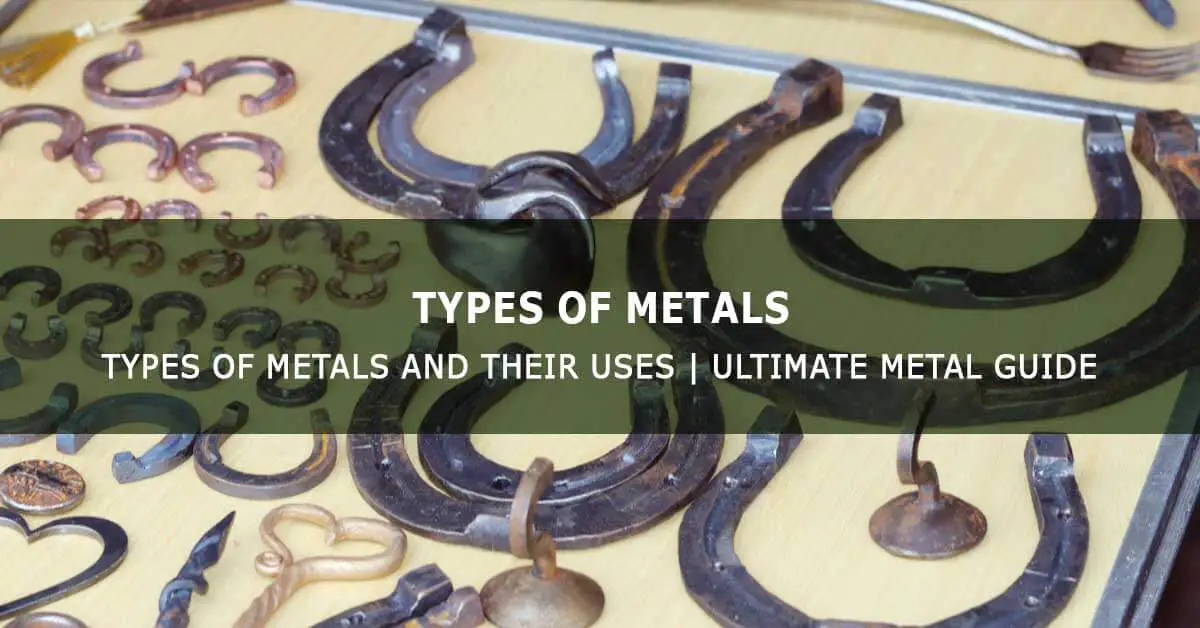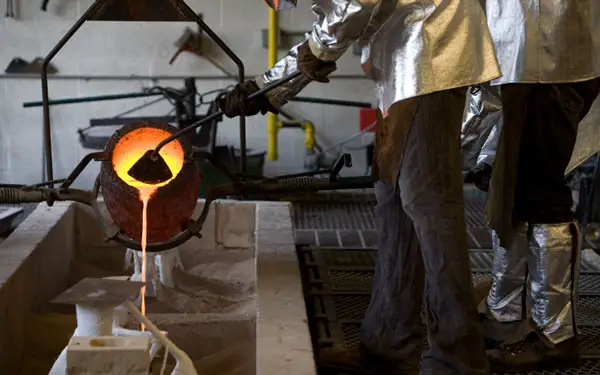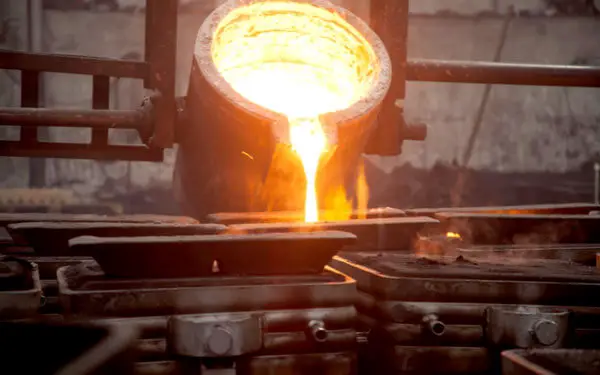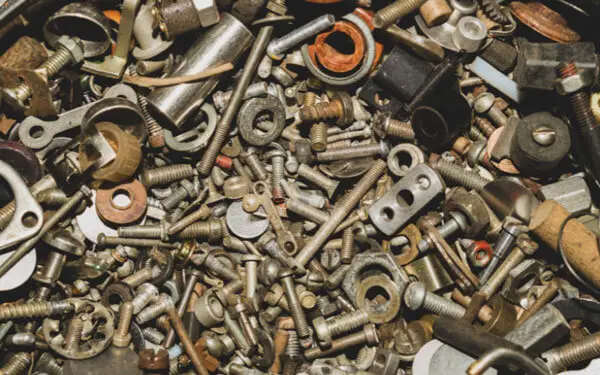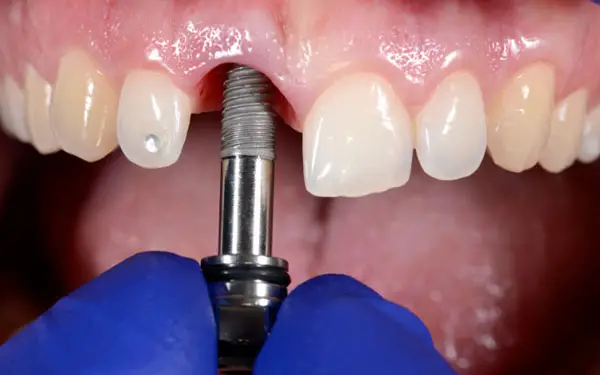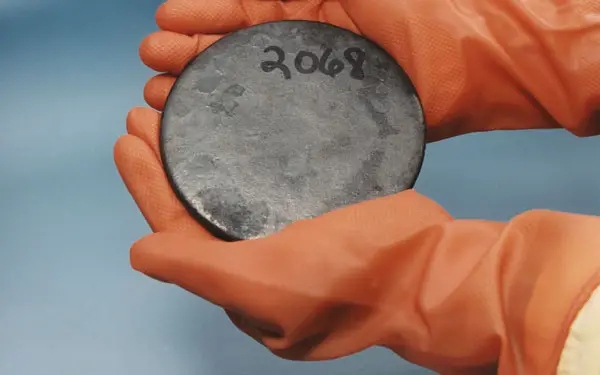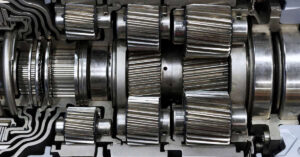Different types of metals are widely used today in various industries due to their unique properties and characteristics. They play an important role in construction, transportation, energy, and countless other sectors. With various types and properties, the world of metals is as fascinating as it is vast.
From iron to aluminum alloys to titanium to zinc, this ultimate metal guide will give you insight into 20 different types of metals and unveils their characteristics and applications. So, buckle up and get ready to dive into types of metals!
List of Different Types of Metals
1. Aluminum
Aluminum is a lightweight but durable non-ferrous metal with excellent corrosion resistance. Due to its high strength-to-weight ratio and malleability, aluminum is used in various applications, from aircraft structures to household items such as cans and foil.
There are two main categories of aluminum: pure aluminum and aluminum alloys. Pure aluminum has high electrical and thermal conductivity and is ideal for electrical applications. On the other hand, aluminum alloys have improved strength and are commonly used in the automotive and aerospace industries.
2. Brass
Brass is a non-ferrous metal alloy made primarily of copper and zinc. The properties of the brass can vary based on the amount of copper and zinc used and can have a range of colors from golden yellow to reddish-brown. It is highly corrosion-resistant and has a low friction coefficient. Therefore, it is ideal for plumbing fixtures, musical instruments, and various decorative applications.
Different types of brass are available, with varying compositions of copper and zinc. For example, Naval brass, resistant to saltwater corrosion, has a higher percentage of zinc. Therefore it is commonly used in marine applications. Cartridge brass, on the other hand, has a higher percentage of copper and is commonly used in ammunition casings and other applications requiring a stronger metal.
3. Bronze
Bronze is a non-ferrous metal alloy made by mixing copper with other metals such as tin, zinc, or lead. The resulting material is stronger and more durable than pure copper, making it perfect for various applications. Bronze is known for its resistance to corrosion and ability to withstand wear and tear.
Some common applications of bronze include manufacturing bushings, bearings, and shaft sleeves due to their low friction coefficient and resistance to wear. Due to its corrosion resistance, bronze is also used in antiques and engineering components cladding.
Bronze is divided into different categories depending on the ratio and type of metals used in the alloy, such as phosphor bronze, aluminum bronze, and silicon bronze.
4. Chromium
Chromium is a hard, lustrous, and corrosion-resistant metal commonly used in industrial applications. It has a high melting point and excellent resistance to tarnishing, making it a popular choice for decorative purposes.
Chromium is used in plating various items, such as automotive parts, to enhance the aesthetic appearance, durability, and resistance to wear and tear. Chromium is added to steel to manufacture stainless steel, which has excellent corrosion resistance and is widely used in construction.
5. Cobalt
Cobalt is a transition metal with magnetic properties and a silvery-blue appearance. It is known for its high melting point and thermal conductivity, making it an ideal metal for various applications, including batteries, superalloys, jet engines, and magnets. It is used in dentistry for dental implants and prosthetics as it is biocompatible and has excellent corrosion resistance.
Cobalt alloys are available in various forms, such as cast cobalt alloys, wrought cobalt-chromium-molybdenum alloys, and cobalt-nickel-chromium-molybdenum alloys. These alloys are known for their excellent wear resistance, high strength, and ability to withstand high temperatures.
6. Copper
Copper is a commonly used metal with excellent electrical and thermal conductivity and high corrosion resistance. It is a soft metal that is easy to shape and can be found in various forms, such as pure copper, copper alloys, and copper-plated materials.
It is commonly used in electrical, plumbing industries, and architectural applications due to its corrosion resistance and ability to form a patina over time. It can also be found in household items such as cookware and jewelry.
Copper alloys include brass and bronze, which are widely used in manufacturing pipes, valves, and fittings, and copper-nickel alloys, which are primarily used in marine applications.
7. Iron
Iron is a strong and durable metal known for its high tensile strength; it is excellent for building and bridge construction. It is also a key component in manufacturing machinery, appliances, vehicle, and tools due to its toughness and resistance to wear. Another common application of iron is in producing steel, an alloy of iron and carbon.
The following are the different types of iron, their properties, and their various applications in different industries:
A. Cast Iron
Cast iron is a group of iron-carbon alloys that contain more than 2% carbon. This high carbon content contributes to its hardness and brittleness. Due to its unique properties, cast iron is commonly used to produce cookware, pipes, and machine parts.
Cast iron’s ability to retain and distribute heat also makes it an ideal material for stove tops and engine blocks.
Cast iron can be classified into four main types: gray, white, ductile, and malleable.
- Gray cast iron: It is the most common type known for its excellent damping capacity and wear resistance.
- White cast iron: It contains carbide impurities, making it harder and more brittle than gray cast iron.
- Ductile cast iron: This type has higher strength and ductility than gray and white cast iron.
- Malleable cast iron: This is heat-treated cast iron to produce a more ductile and malleable material.
B. Wrought Iron
Wrought iron is a soft and ductile metal known for its toughness and malleability. It is a pure form of iron that contains very little carbon and other impurities, which makes it less brittle than cast iron. Wrought iron also has excellent corrosion resistance.
Wrought iron is used in various applications, including ornamental work, furniture, and decorative pieces. Due to its unique look and texture, it is often found in antique or vintage pieces.
There are two types of wrought iron – charcoal iron and puddled iron. Charcoal iron is produced by heating iron ore in a charcoal fire, while puddled iron is created by melting pig iron and removing impurities through puddling.
8. Lead
Lead is a dense and soft metal commonly used in various applications, mainly due to its resistance to corrosion and malleability. Its high density also makes it an excellent material for radiation protection.
One of the most common applications of lead is in batteries, particularly in manufacturing lead-acid batteries. It is also used in the construction industry for roofing, flashings, and gutters due to its durability and ease of shaping.
A few types of lead are available, including pure lead and lead alloys. Lead alloys are commonly used in manufacturing ammunition and radiation shielding applications due to their high density and ability to absorb radiation.
9. Magnesium
Magnesium is a lightweight metal that possesses a high strength-to-weight ratio. This metal is known for its excellent electrical and thermal conductivity and its corrosion resistance.
One of the most common applications of magnesium is in manufacturing aluminum alloys. Magnesium is also used to produce various products, including camera bodies, laptop cases, and mobile phone frames.
Different types of magnesium are available, including pure magnesium and magnesium alloys. Magnesium alloys are commonly used in applications due to increased strength and heat resistance. Some of the popular magnesium alloys include AZ31, AZ91, and AM60.
10. Nickel
Nickel is a silvery-white metal that is known for its excellent corrosion resistance. It is a hard and ductile metal used to manufacture a wide range of products.
Nickel is commonly used in the production of stainless steel. It is also used in manufacturing electrical components, such as batteries and electrical wiring, due to its high electrical conductivity. It is used to produce coins, magnets, and certain types of jewelry.
11. Palladium
Palladium is a silvery-white metal with a soft texture resistant to corrosion. It is used in electrical applications due to its high melting point and excellent thermal conductivity.
Common applications of palladium include jewelry, dental fillings, and electronics such as mobile phones and laptops. Palladium is also used in the automotive industry as a catalyst in catalytic converters, helping to reduce harmful emissions.
12. Platinum
Platinum is a highly valued metal due to its remarkable properties, including its resistance to corrosion and high melting point. It is also known for its exceptional thermal conductivity.
In addition to its industrial uses, platinum is also used in jewelry and as a material for medical equipment. Its durability and hypoallergenic properties make it a popular choice for wedding and engagement rings.
Platinum comes in different types, including pure platinum and platinum alloys. Pure platinum has a silvery-white appearance and is the most ductile and malleable of all metals. Platinum alloys are created by combining platinum with other metals such as gold, copper, and palladium to improve certain properties such as hardness and durability.
13. Steel
Steel is a common ferrous metal widely used in construction, manufacturing, and various other industries. It is made primarily from iron, along with small amounts of carbon and other alloying elements that give it unique properties. Steel is known for its strength, durability, and versatility, as it can be shaped into a wide range of products and structures.
Some common steel applications include buildings, bridges, ships, cars, appliances, and machinery. It is also used to produce tools, weapons, and various types of equipment.
The following are the different types of steel, their properties, and their various applications:
A. Carbon Steel
Carbon steel is produced by adding carbon to iron, which increases its hardness and tensile strength. This type of steel is commonly used to produce buildings, bridges, ships, and vehicles. It is also used to manufacture tools, equipment, and machinery due to its ability to withstand high pressure and stress.
Carbon steel can be further categorized based on its carbon content, with low carbon steel having a carbon content of up to 0.3%, medium carbon steel having a carbon content between 0.3% and 0.6%, and high carbon steel having a carbon content greater than 0.6%. The amount of carbon in carbon steel affects its strength, ductility, and machinability.
B. Alloy Steel
Alloy steel, as its name suggests, is a type of steel composed of various elements in addition to iron and carbon. These additional elements improve the mechanical properties of the steel, such as its strength, durability, and toughness. Alloy steel is also known for its resistance to wear, corrosion, and heat.
Common alloy steel applications include manufacturing automobiles, aircraft, pipelines, machinery, and construction of buildings, bridges, and offshore structures.
C. Stainless Steel
Stainless steel is a type of metal known for its high resistance to corrosion and staining. It contains a minimum of 10.5% chromium, which provides a protective layer that prevents the steel from rusting.
Common applications of stainless steel include the production of kitchen utensils, medical equipment, and jewelry and the construction of buildings, bridges, and other infrastructure due to its durability, high strength, and corrosion resistance.
There are several types of stainless steel, each with unique properties and uses. Some common grades include austenitic, martensitic, ferritic, and duplex stainless steel.
14. Tin
Tin is a soft, malleable, and ductile metal commonly used for coating items prone to corrosion. It is highly resistant to corrosion and can form alloys with other metals.
Common tin applications include the production of canned food, electronic components, and tinplate steel. Tin is also used as a coating material for other metals to increase their resistance to corrosion.
15. Titanium
Titanium is a strong, lustrous, lightweight metal with excellent corrosion resistance. It is also biocompatible and non-toxic, making it a popular material for medical implants. Moreover, titanium is also used to construct airplanes, spacecraft, industrial equipment, jewelry, and sports equipment.
Titanium has a high strength-to-weight ratio; therefore, it can withstand high-stress levels without adding significant weight to the structure. Titanium is also resistant to extreme temperatures, low thermal conductivity, and high corrosion resistance.
16. Tungsten
Tungsten is a hard and dense metal with one of the highest melting points of all metals and excellent resistance to corrosion. Its high melting point makes it ideal for applications requiring high temperatures, such as electrical contacts, welding electrodes, and furnace components.
Due to its hardness, it is also commonly used to produce cutting tools and wear-resistant parts. Tungsten carbide is a type of tungsten alloy used to produce drill bits, cutting tools, and wear-resistant components.
17. Uranium
Uranium is a naturally occurring element; it is a highly dense and heavy metal found in soil, rocks, and water. One of the most notable uses of uranium is as a fuel source for nuclear power plants. Aside from its energy applications, uranium is also used to produce military weapons.
Uranium has several isotopes, but uranium-235 is fissile, meaning it can undergo nuclear fission. The uranium-235 reaction releases a huge amount of energy and is the basis for nuclear power generation. Uranium-235 and its isotopes can be used to create nuclear bombs.
Uranium-235 makes up only a small fraction of natural uranium deposits. Therefore, it must be enriched to increase its concentration before it can be used in power plants.
18. Vanadium
Vanadium is a transition metal known for its excellent hardness, strength, and durability. It has a silvery-grey appearance and is commonly found in nature as a mineral. Vanadium has high corrosion resistance.
Common applications of vanadium include manufacturing steel alloys, as it gives steel exceptional strength and enhances its resistance to corrosion. Vanadium is also used as a catalyst in the production of sulfuric acid and the manufacture of ceramics and electronic devices.
19. Zinc
Zinc is a silvery-blue metal with a moderate melting point and a relatively low density. It is highly ductile and malleable and has excellent electrical conductivity.
One of the common uses of zinc is in producing galvanized steel, which is used in construction and automotive manufacturing due to its excellent corrosion resistance. Zinc is also widely used in the production of brass and bronze alloys. Electrical equipment and batteries also commonly use zinc due to their high electrical conductivity and low cost.
20. Zirconium
Zirconium is a lustrous, silvery-gray metal commonly found in many minerals. It has high corrosion resistance, making it a popular choice for chemical processing applications. Zirconium also has excellent mechanical properties, such as high strength and toughness and good heat and wear resistance.
Zirconium is widely used in nuclear reactors due to its low thermal neutron cross-section, which is ideal for fuel cladding and structural materials. It is also used in the production of alloys, such as Zircaloy. In addition, zirconium is used to make high-performance pumps, valves, and heat exchangers in the chemical processing industry.
Did you know?
- Steel is the world’s most commonly used metal and one of the most recycled materials.
- Platinum group metals, including platinum, palladium, and rhodium, are used in catalytic converters to reduce harmful vehicle emissions.
- The heaviest metal is Osmium, while the lightest is Lithium.
- The most common types of metals are; Iron, Aluminum, Copper, Zinc, Nickel, Lead, Gold, Silver, Titanium, Magnesium, Platinum, Palladium, Tin, Tungsten and Cobalt.
- Copper alloys have excellent electrical conductivity, which makes them ideal for electrical wiring.
- Mercury is the only metal that is liquid at room temperature.
- Metal 3D printing allows complex and intricate designs to be created quickly and efficiently.
- Wrought iron is a popular choice for ornamental pieces due to its malleability and decorative appearance.
- Alloy steel is widely used for its excellent corrosion resistance.
- Metal roofing has many benefits, including its resistance to weather, durability, and low maintenance.
- Titanium is a highly sought-after metal for its strength and resistance to corrosion.
- There are over 86 known types of metals, there are also several types of alloys, which are combinations of multiple metals.
Conclusion
Understanding the types of metals is essential for a wide range of industries. From the automotive industry to electronics, construction, and jewelry making, metals play a crucial role.
Knowing the properties and characteristics of different types of metals helps us select the right one for our application. Moreover, understanding metal finishing processes and techniques can enhance the functionality and longevity of the final product.
References:
- The SAE Grading System.

